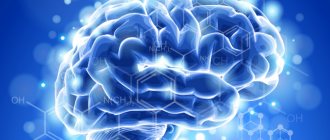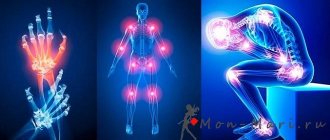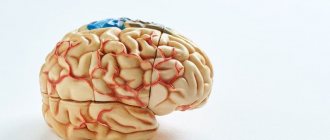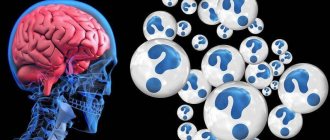Somatoform disorder is a pathology that belongs to the group of neuroses, but has a slightly different category. This is more significantly due to the fact that more anxiety is caused by actual somatic complaints and complaints about the disorder, and not by emotional states. Rarely will a patient complain of fear, but rather of pain somewhere. That is why everyone who wants to treat this group of pathologies undertakes to treat, and no one really treats them, only transferring patients. First of all, people with somatoform disorder, of course, turn to family doctors, who for the most part undertake to treat a non-existent pathology. And the movement begins in a circle with all kinds of diagnostic procedures and an ever-increasing amount of medications. All narrow therapeutic specialists, depending on the subtype of somatoform disorder, as well as neurologists, and after undergoing all kinds of treatments, psychiatrists, join in the treatment of this pathology.
Development mechanism
The autonomic department of the nervous system regulates the functioning of all internal organs. In addition, it controls many physiological processes. If the autonomic nervous system functions normally, the internal organs work harmoniously, promptly ensuring their adaptation to constantly changing conditions. For example, this department regulates breathing and the frequency of contractions of the heart muscle, heat exchange.
Like the central nervous system, the autonomic region is represented by a system of neurons. These are cells that have a complex structure and perform many functions. Under the influence of various provoking factors, a disorder of the autonomic (vegetative) nervous system can develop. In such cases, the patient’s general condition worsens significantly, as the functioning of most internal organs is disrupted.
Causes
Disorders of the autonomic (autonomic) nervous system are divided into the following types:
- Somatoform. This is the disorder that is easiest to treat. It develops against the background of chronic stress in a person. The somatoform type of disorder is a type of neurosis. The difficulty of diagnosing it lies in the fact that the symptoms of the disease manifest themselves in the form of signs of various pathologies of a chronic nature, which a person actually does not have.
- Damage to subcortical structures. The main causes of the disorder are brain injuries and residual disease of the central nervous system. The disorder manifests itself in the form of an attack, after which the person feels severe lethargy and weakness.
- Continuous irritation of peripheral autonomic structures. Occurs with urolithiasis, PMS and cervical dorsopathy.
The code for the above disorders in ICD-10 is G90 “Disorders of the autonomic (autonomic) nervous system. In some cases, it is not possible to identify the true cause of the disease. In such situations, it is customary to talk about an unspecified disorder of the autonomic nervous system. The code for such a pathology in ICD-10 is G90.9.
Provoking factors for the development of disorders are the following conditions:
- Prolonged stay in a state of stress.
- Genetic predisposition.
- Hormonal imbalance (including those associated with natural age-related changes in the body).
- A lifestyle that does not involve regular physical activity.
- Unbalanced diet, excessive consumption of fatty and fried foods, fast food.
- Tobacco smoking.
- Regular consumption of alcoholic beverages.
- Violation of the integrity of nerve fibers resulting from trauma, injury and after surgery.
- Intoxication of the body.
- Long-term and especially uncontrolled use of medications.
- Allergic reactions.
It is important to know that a disorder of the autonomic nervous system of any type is one of the manifestations of an existing serious disease. It is not recommended to self-medicate; only a doctor can determine the true cause of the disorder and correctly draw up a treatment regimen.
Stages and forms of pathology
There are two main stages of pathology: exacerbation with pronounced symptoms and remission, when signs of pathology weaken or completely disappear. In addition, the nature of the SVD is as follows:
- paroxysmal, when panic attacks periodically occur, during which the symptoms become more pronounced and then noticeably weaken;
- permanent, characterized by weak symptoms.
- Erectile dysfunction - why it occurs, how to treat it with medications, a vacuum pump or surgery
- Albright McCune syndrome - symptoms, signs and manifestations of the disease, methods of correction and prognosis
- Abdominal pain - why it occurs and how to relieve an attack, types by nature and intensity
To facilitate diagnosis, it was decided to classify autonomic dysfunction into types, taking into account the activity of which part of the ANS is enhanced. Depending on this, SVD can occur in one of the following types:
- According to cardiac, or cardiac. In this case, the sympathetic department of the ANS works too actively. The human condition is accompanied by anxiety, fear of death, and increased heart rate. The patient may have increased blood pressure, weakened intestinal motility, and developed motor restlessness.
- According to hypertensive. Accompanied by increased blood pressure. In this case, the person develops the following symptoms: nausea, vomiting, hyperhidrosis, fog before the eyes, fears, nervous tension.
- According to hypotonic. With excessive activity of the parasympathetic nervous system, the pressure drops to 90-100 mmHg. Art. Against this background, there are difficulties with breathing, pale skin, a feeling of weakness, bowel movements, heartburn, nausea, and weakening of the pulse.
- According to vagotonic. It manifests itself in childhood in the form of poor sleep, fatigue, and gastrointestinal disorders.
- According to mixed. With this type of autonomic dysfunction syndrome, symptoms of its different forms are combined or alternated. Most patients experience hyperhidrosis, tremor of the hands, low-grade fever, flushing of the chest and head, acrocyanosis, and red dermographism.
Clinical manifestations
Disorders of the autonomic (autonomic) nervous system (including unspecified) do not have specific symptoms. Most people mistake the discomfort that arises for manifestations of existing diseases.
The main types of symptoms of a disorder of the autonomic (autonomic) nervous system are as follows:
- Cardiovascular syndrome. Includes sudden jumps in blood pressure, impaired peripheral circulation, sudden discomfort in the heart area and disruption of the rhythm of this muscle.
- Hyperventilation syndrome. The patient experiences rapid breathing, muscle spasms, and a faint state. It's as if the person doesn't have enough air. He also complains of partial loss of sensation in his limbs.
- Irritable bowel syndrome. Includes episodes of diarrhea, frequent urge to defecate, flatulence, muscle spasms, and pain in the lower abdomen.
In addition, the following conditions are symptoms of the pathology:
- Nausea, often turning into vomiting.
- Feeling of a lump in the throat, making it difficult to swallow food.
- Discomfort in the epigastric region.
- Appetite disorders.
- Frequent episodes of painful urine discharge that are not a consequence of diseases of the genitourinary system.
- Sexual disorders. In men, both erection and ejaculation are impaired. Women develop anorgasmia and vaginismus. Libido decreases in both sexes.
- Chills.
- Increased body temperature.
If these nonspecific symptoms occur, it is important to consult a doctor promptly. The specialist will make the correct diagnosis and find out the true causes of the syndrome.
Disorders of the autonomic (vegetative) nervous system can lead to complications if left untreated.
Somatoform pain disorder
This type of disorder has a chronic course and constantly forces the individual to complain of various types of pain. In this case, pain can reach unlimited, severe levels. In particular, individuals often themselves note that it would be better to just be sick than this horror. That is, the perception systems themselves tolerate such sensations much worse. Classically, the patient himself undoubtedly finds pathology in some specific organs and requires a detailed study. In this case, the studies do not produce results, the patient begins to undergo treatment on his own, accusing all doctors of negligence and mediocrity. This pathology is time-consuming and lasts for at least six months.
Neurotic somatoform disorders can also manifest themselves in a variety of pain forms and are intertwined with the hypochondriacal form of the disorder. Such disorders force the individual to constantly be in a state of fear and believe that he has some dangerous intolerable disease. Diseases are necessarily fatal and incurable. This will be cancer of some etiology and localization, starting from complaints. Sometimes these are heart diseases that bother the individual, for example, coronary artery disease. Without finding the disease, the doctor risks turning into an incompetent barber and will receive complaints to all sorts of authorities. Diagnoses always change without absolute logic; these can be significant leaps, for example, from ischemic heart disease to tumors. In an undifferentiated disorder, the nature of the complaints is so polymorphic that it does not allow the individual to get rid of his fears and does not allow him to assume any existing diagnosis.
Somatoform pain disorder can have symptoms from absolutely any system of the body, which is why no doctor is immune from the arrival of such a patient. The most common forms are still easy to list:
• The algic form of somatoform disorder is severe pain that migrates throughout the body. Severe migraines, various types of headaches, as well as general malaise are characteristic of this form. There may also be pain and complaints from the GCT, gastralgic form. At the same time, the complaints, as always, are absurd and do not fit into more than one known pathology. On the part of the respiratory system there will be a pseudopulmonary form, which completely disables the possibility of physical activity, and also greatly worsens the quality of life due to shortness of breath of varying strength, cough, bronchorrhea, and sometimes even mucus secretion. Cardiac complaints vaguely resemble ischemic heart disease, but it is difficult to find cause-and-hereditary relationships and, naturally, cardiac medications will not help.
• Pseudo-urogenital type of somatoform disorder is the most polymorphic subtype, with many complaints. These are complaints from the urinary system, in particular enuresis, some problems with urination, such as cystitis. Also excessively frequent urge and polyuria. The patient may be bothered by excessive sensitivity and pain when urinating. But their most pressing complaints are usually in the intimate sphere; women sometimes even develop amenorrhea. But the most difficult thing is a significant decrease in libido, up to complete frigidity and even the formation of hatred towards men. Also, men often experience impotence in its various forms. Sometimes an individual can experience pleasure only in some exceptional cases when all strange requirements are functionally fulfilled.
It is worth noting that when a somatic pathology is found, one should not exclude the additional presence of a somatoform disorder, especially if the pathology is of the somato-psychic variety. It is possible that the pathology can be combined. This is especially true in the case of strange complaints that do not fit into the main picture.
Diagnostics
Initially, it is recommended to consult a therapist. This is a general specialist who, if a disorder is suspected, will refer you to a neurologist for consultation.
It is important to remember that disruption of the autonomic nervous system does not have specific manifestations. In this regard, a comprehensive examination is necessary to make a correct diagnosis. It involves passing laboratory and instrumental tests from a gastroenterologist, cardiologist, oncologist, endocrinologist, etc.
A disorder of the autonomic (autonomic) nervous system is confirmed if diseases with similar symptoms were not identified during the diagnostic process.
Classification of somatoform disorders of the autonomic nervous system
There is no generally accepted typification in evidence-based medicine. But when making a diagnosis, many doctors use the Soviet classification, introduced into medical use in 1987.
Dysfunction happens:
- Primary and secondary.
- With a predominance of sympathicotonic, vagatonic or mixed symptoms.
- According to the type of course of the disease (can occur hidden in a latent form), paroxysmal (manifest in panic attacks or vegetative crises), and also systematically (with a permanently present clinical picture of the disease). In turn, paroxysms can manifest themselves as vagoinsular, sympathoadrenal and mixed crises.
- By severity (mild, moderate and severe).
- Autonomous type and as a symptomatic manifestation of another disease.
Autonomic dysfunction can occur at the level of different systems of the human body:
- Circulatory system and heart (code F 45.30) – these are diseases such as vegetative-vascular dystonia, cardioneurosis, cardiophobia, manifested by a painful syndrome and fear for one’s heart.
- Upper and lower gastrointestinal tract (F45.31 and F45.32) - includes gastric neurosis, dyspepsia, aerophagia of a psychogenic nature, functional intestinal disorders, etc.
- Egetative disorder of the respiratory system (F45.33) – shortness of breath, feeling of incomplete inspiration, lack of oxygen, intolerance to stuffiness, coughing attacks or laryngospasms.
- Disturbance of the genitourinary system (F45.34) – painful sensations or increased frequency of urination, other forms of psychogenic dysuria.
Drug treatment
It is a mandatory item in the treatment regimen. Drugs should be selected by a doctor based on diagnostic results and taking into account the individual health characteristics of the patient.
Treatment of a disorder of the autonomic (autonomic) nervous system involves taking medications. which include:
- Sedative drugs. They have a calming effect. Their active components have a positive effect on the nervous system as a whole. Most often, doctors prescribe products based on valerian, hawthorn, motherwort, and St. John's wort. Trade names of the drugs: “Novo-passit”, “Stressplan”, “Persen”.
- Anxiolytic drugs. In other words, tranquilizers. Their use is especially indicated for severe disorders of the autonomic (autonomic) nervous system. The drugs help relieve the patient from causeless feelings of anxiety, severe stress and unreasonable attacks of fear. Most often doctors prescribe: Afobazol, Atarax, Seduxen, Tranxen, Stresam, Diazepam.
- Antidepressants. The purpose of taking them is to improve the degree of mental activity. Always prescribed for somatoform and other disorders of the autonomic nervous system. The active components of the drugs help eliminate feelings of apathy, depression, and anxiety. As you take it, depression subsides and your psycho-emotional state stabilizes. In addition, antidepressants are prescribed to patients suffering from chronic pain syndrome that is not amenable to symptomatic therapy. Names of drugs: Amitriptyline, Azafen, Milnacipran, Valdoxan, Prozac. In the presence of severe disorders, taking one of the following drugs is indicated: “Sulpiride”, “Teraligen”.
- Nootropics. They have a cerebroprotective effect. Prescribed to improve mental performance and increase the brain's resistance to stressful situations. In addition, while taking nootropics, the energy balance of nerve cells is normalized. As a rule, doctors prescribe: Pyritinol, Phenibut, Piracetam.
- Psychostimulants. Indicated in the presence of severe depressive states, vagotonia, hypotension, bradycardia. In most cases, doctors prefer herbal-based products, which can be combined with Duplex injections and Sidnocarb. In the presence of intracranial hypertension, Glycerol and Diacarb are additionally prescribed. In order to improve microcirculation, Cavinton, Trental and Stugeron are recommended. If necessary, calcium and potassium supplements, vitamins E and group B are prescribed.
Depending on the severity of the disease, this treatment regimen can be expanded by the doctor.
Symptoms of somatoform disorder
In the format of this pathology, the symptoms are completely blurred, difficult to associate with any other groups and do not fit into more than one group of somatic diseases. The somatics of somatoform disorders is not always the key symptom; emotional instability with a variety of affective states often predominates. Often, a doctor may be surprised that a person describes not the actual complaints, but what she felt. For example, I experienced such panic when I had a headache. You are trying to convince and indicate that this is normal, because everyone worries when something hurts, but the patient continues to focus on the sensations without really describing the complaints. It is also worth noting that the nature of the complaints cannot be limited to one system and they, as a rule, are not entirely realistic: the head is drilled, the stomach splashes and similar absurdities. Such individuals will never agree with the mental component of this pathology; the first doctor who makes an attempt to hint about this will immediately turn out to be a stupid bribe-taker who does not cure. In the conversation, their lack of restraint and exaggeration of complaints are immediately noticeable. But if you don’t get irritated, but calmly talk to them, asking them in more detail, then you can detect psychiatric complaints: decreased mood, apathy, reluctance to do the slightest activity. It is worth pointing out that they are also terribly irritable and cannot stand it when something does not happen the way they want. The exacerbation and deterioration of the condition are always based on common psychological factors.
The syndromes of somatoform disorders are so polymorphic that they are divided into massive groups. Conversion syndromes involve a certain change in body functions. Sometimes these are extreme degrees of loss of function, up to deafness or similar symptoms. Often this can be parasthesia, a type of altered sensation. Often there may also be a disturbance of smell, various tics, ataxia, such as unsteadiness of gait. Such disorders are difficult to differentiate from neurasthenia, as well as pathologies of the neurotic spectrum. Conversion is the transformation, in the case of somatoform disorders, of mental needs into physical problems. Thus, the subconscious attracts the attention of both the individual and the general public.
Asthenic groups of symptoms are the most common due to their non-specificity. Such symptoms of somatoform disorders are most often discovered at an appointment with a family doctor. Exhaustion is usually caused by significant neuropsychic overexcitability. Typically, patients are also exhausted by headaches, irritability and intolerance to a significant number of triggers. Often individuals notice that they are never rested and do not feel joy and freshness. They tolerate stress with considerable difficulty, especially in the second half of the day. Often there are also complaints that are similar to some somatic ones: palpitations, menstrual irregularities, surges and changes in blood pressure. Very often, the symptoms are similar to cystitis and genital disorders.
Depressive syndromes in this pathology are not classic. That is, there may not be a decrease in mood, movements and thought processes, but masked depression develops fully. These include: cardiological - with a predominance of cardiac complaints; gastralgic, with a predominance of intestinal complaints; algic - characterized by pain of different localizations; dysuric - manifesting itself in potency disorders and urinary complaints; pseudopulmonary - with complaints of shortness of breath and similar respiratory symptoms.
Anorexia nervosa is a symptom that accompanies almost all pathologies of the neurotic spectrum. All this is connected with an exorbitant desire to look better and lose weight. The syndrome is not very favorable; it indicates the neglect of the neurosis. Previously, women were more susceptible, but this trend is quickly leveling out. It can be suspected when an individual has lost more than 25 percent of his weight and also avoids eating. In girls this is always accompanied by amenorrhea.
Dysmorphophobia is a symptom that manifests itself in fear of one’s body or certain parts of it. But not in the usual form of fear, but precisely in the understanding of the terribleness of some parts of one’s body. Body dysmorphophobia is an extreme degree of the previous phenomenon, manifested in non-acceptance of oneself and one’s appearance and a feeling of terribleness. For example, huge hands, fat legs and the like. Moreover, this is always unjustified criticism; usually the individual has completely normal parameters. They hide these feelings, realizing that this is far from the norm. This can only be revealed indirectly or by talking to someone they trust.
Other conservative treatment methods
The diagnosis of “disorder of the autonomic (autonomic) nervous system” requires an integrated approach. Taking medications is not enough to get rid of the disease.
The pathology treatment regimen also includes the following points:
- Lifestyle changes. The patient must avoid getting into stressful situations both at home and at work. It is also important to properly organize your work and rest schedule. Any overwork negatively affects the functioning of the nervous system. A person diagnosed with any type of disorder (including unspecified) is prohibited from working in emergency mode. In addition, it is necessary to make adjustments to the diet. The menu should include vegetables, fruits and protein foods. At the same time, it is advisable to exclude fatty, fried and smoked foods, easily digestible carbohydrates, carbonated drinks and alcohol from the diet. It is recommended to spend more time outdoors. The most suitable types of physical activity are yoga and swimming.
- Physiotherapy course. The goal of treatment is to eliminate muscle tension, relax the patient, and improve lymph and blood circulation. As a rule, doctors prescribe stone therapy, acupuncture, mud baths, massage and electrophoresis.
- Working with a psychologist. Consultation with a specialist is especially recommended for people suffering from workaholism. Such people are constantly in a stressful situation and are accustomed to working in emergency mode. In most cases, they ignore the first symptoms of disorders. The disorder of the autonomic (autonomic) nervous system, meanwhile, progresses and can become severe. The difficulty is that most people deny the need to see a psychologist.
Thus, to get rid of the disease, you need not only to take the medications prescribed by your doctor in a timely manner, but also to make adjustments to your lifestyle.
Traditional methods of treatment
It is important to understand that the use of unconventional methods of therapy does not eliminate the need to seek qualified medical help. In addition, the use of any medications must be agreed upon with a doctor to prevent a decrease in the effectiveness of the medications.
For disorders of the autonomic nervous system, herbal decoctions based on St. John's wort, hawthorn, radiola and rosehip have a positive effect. They must be taken daily, 200 ml. The daily dose can be divided. The course of treatment lasts from 6 to 8 weeks. If necessary, it can be repeated after a month's break.
If left untreated
It is important to understand that the autonomic nervous system regulates the functioning of all internal organs. If there are disturbances in its functioning, they receive irregular or completely incorrect impulses. As a result, the functioning of organs is disrupted, the immune system is significantly weakened, which threatens the development of all kinds of diseases.
In addition, ignoring the problem leads to the fact that poor health becomes a constant companion of a person. Unfounded fears begin to disturb him, and he becomes depressed. Sometimes there are attacks of a sharp deterioration in health. During this period, symptoms of myocardial infarction, migraine, osteochondrosis and a number of other diseases appear. As a result, there is a tendency towards alcoholism and suicide.
What does the diagnosis mean - VSD of mixed type
VSD is also known as neurocirculatory dystonia (ICD code 10). Somatoform dysfunction is of a psychosomatic nature and leads to a disorder of the two main nerve divisions in the human body - the sympathetic and parasympathetic. One of them is responsible for relaxing the body, the other for tension. The departments are connected by a nervous chain to all organs and literally control them.
The autonomic nervous system controls all processes in the body, especially digestive function, the endocrine system, and the vascular system.
When working in harmony, these departments are activated at the right time, without causing any unpleasant symptoms in a person. For example, when we see danger and prepare to defend ourselves, the sympathetic department is activated. It mobilizes the body, produces reserve energy, strains the muscular system, and disables some organs (bladder, stomach) for the duration of the “battle.”
When we are in a pleasant atmosphere, we feel good and calm, the parasympathetic department turns on. It causes blood vessels to dilate, the heart to beat slower, makes breathing smooth and deep and relaxes the entire body.
The diagnosis of “vegetative-vascular dystonia of mixed type” means that there has been a complete failure in the operation of these systems. And where a person should be relaxed, a completely different reaction is activated, and vice versa. Often dysfunction brings such chaos into the body that the unfortunate person develops a huge number of unpleasant symptoms, where one can quickly be replaced by another.
The prefix “mixed type” means that the patient does not have predominant symptoms, they are mixed in their manifestation; there are many of them.
VSD is most affected by teenagers and people aged 20 to 40 years. Dystonia is observed more often in women than in men. Vegetative-vascular dystonia rarely occurs in children and the elderly.
In foreign countries, the diagnosis of “mixed type VSD” does not exist. Doctors in European countries use the term “neurocirculatory dystonia” and do not refer to this disorder as a disease.
Forecast
The outcome of the disease directly depends on the timeliness of visiting a doctor. If treatment was carried out on time, the prognosis is favorable.
The doctor determines the success of treatment according to several criteria:
- The patient's headaches disappear and paroxysmal manifestations are completely stopped.
- The degree of efficiency increases.
- Mood improves, depression and inexplicable fears recede.
- Sleep is normalized.
In other words, if after treatment a person’s quality of life improves or at least returns to its previous level, the doctor considers the therapy successful. To avoid re-development of a disorder of the autonomic (autonomic) nervous system, it is necessary to follow the principles of a healthy lifestyle. It is important to eliminate the main provoking factors: stress, overwork, consumption of alcoholic beverages.
Ignoring the disease leads to the development of complications. If qualified assistance is not provided to the person at this stage, the prognosis can be considered unfavorable. If the patient has a disorder, the participation of loved ones is of great importance. As a rule, they are the ones who convince a person that seeing a doctor is vitally important.











